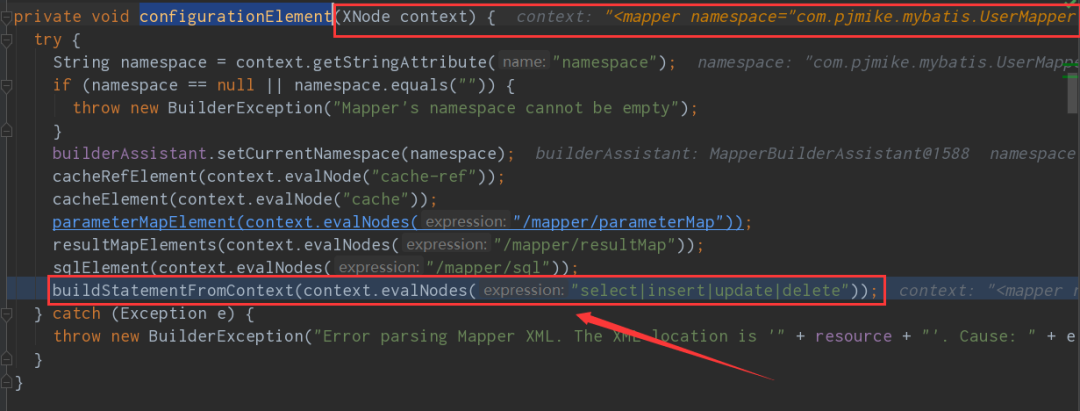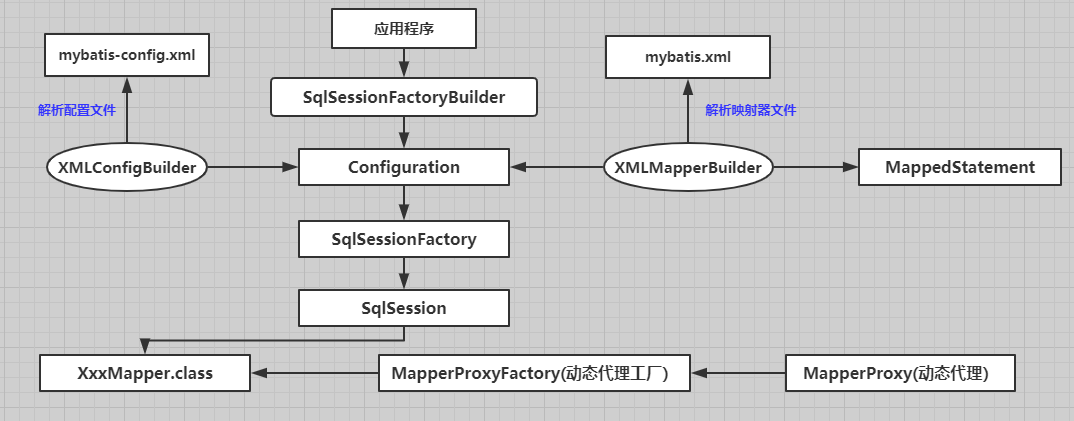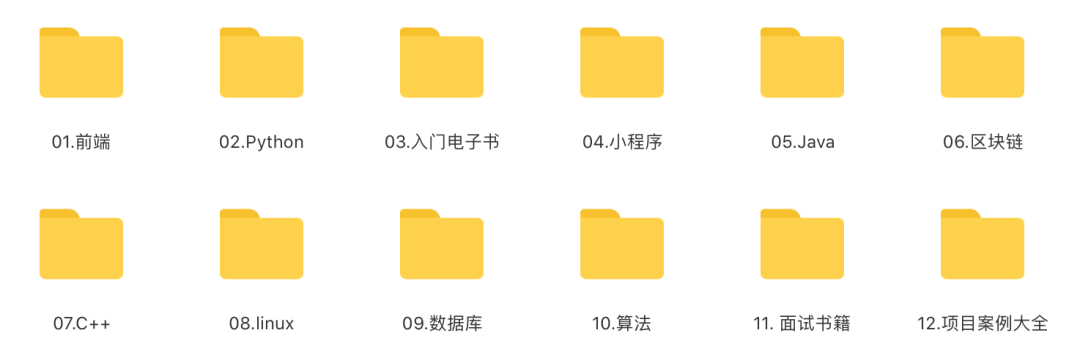MyBatis的动态代理实现细节
点击上方 蓝字 关注我们!
Java,Python,C/C++,Linux,PHP,Go,C#,QT,大数据,算法,软件教程,前端,简历,毕业设计等分类,资源在不断更新中... 点击领取!
前言
一直以来都在使用MyBatis做持久化框架,也知道当我们定义XXXMapper接口类并利用它来做CRUD操作时,Mybatis是利用了动态代理的技术帮我们生成代理类。那么动态代理内部的实现细节到底是怎么的呀?XXXMapper.java类和XXXMapper.xml到底是如何关联起来的呀?本篇文章就来详细剖析下MyBatis的动态代理的具体实现机制。
MyBatis的核心组件及应用
在详细探究MyBatis中动态代理机制之前,先来补充一下基础知识,认识一下MyBatis的核心组件。
SqlSessionFactoryBuilder(构造器):它可以从XML、注解或者手动配置Java代码来创建SqlSessionFactory。 SqlSessionFactory: 用于创建SqlSession (会话) 的工厂 SqlSession: SqlSession是Mybatis最核心的类,可以用于执行语句、提交或回滚事务以及获取映射器Mapper的接口 SQL Mapper:它是由一个Java接口和XML文件(或注解)构成的,需要给出对应的SQL和映射规则,它负责发送SQL去执行,并返回结果
“注意:现在我们使用Mybatis,一般都是和Spring框架整合在一起使用,这种情况下,SqlSession将被Spring框架所创建,所以往往不需要我们使用SqlSessionFactoryBuilder或者SqlSessionFactory去创建SqlSession
下面展示一下如何使用MyBatis的这些组件,或者如何快速使用MyBatis:
数据库表
CREATE TABLE user(
id int,
name VARCHAR(255) not NULL ,
age int ,
PRIMARY KEY (id)
)ENGINE =INNODB DEFAULT CHARSET=utf8;
声明一个User类
@Data
public class User {
private int id;
private int age;
private String name;
@Override
public String toString() {
return "User{" +
"id=" + id +
", age=" + age +
", name='" + name + '\'' +
'}';
}
}
定义一个全局配置文件mybatis-config.xml (关于配置文件中具体属性标签解释参阅官方文档)
"1.0" encoding="UTF-8" ?>
"-//mybatis.org//DTD Config 3.0//EN"
"http://mybatis.org/dtd/mybatis-3-config.dtd">
"development">
"development">
type="MANAGED" />
type="POOLED">
"driver" value="com.mysql.jdbc.Driver" />
"url" value="jdbc:mysql://localhost:3306/test"/>
"username" value="root" />
"password" value="root" />
"mapper/UserMapper.xml"/>
UserMapper接口
public interface UserMapper {
User selectById(int id);
}
UserMapper文件
"-//mybatis.org//DTD Mapper 3.0//EN"
"http://mybatis.org/dtd/mybatis-3-mapper.dtd">
"com.pjmike.mybatis.UserMapper">
"selectById" parameterType="int"
resultType="com.pjmike.mybatis.User">
SELECT id,name,age FROM user where id= #{id}
测试类
public class MybatisTest {
private static SqlSessionFactory sqlSessionFactory;
static {
try {
sqlSessionFactory = new SqlSessionFactoryBuilder()
.build(Resources.getResourceAsStream("mybatis-config.xml"));
} catch (IOException e) {
e.printStackTrace();
}
}
public static void main(String[] args) {
try (SqlSession sqlSession = sqlSessionFactory.openSession()) {
UserMapper userMapper = sqlSession.getMapper(UserMapper.class);
User user = userMapper.selectById(1);
System.out.println("User : " + user);
}
}
}
// 结果:
User : User{id=1, age=21, name='pjmike'}
上面的例子简单的展示了如何使用MyBatis,与此同时,我也将用这个例子来进一步探究MyBatis动态原理的实现。
MyBatis动态代理的实现
public static void main(String[] args) {
try (SqlSession sqlSession = sqlSessionFactory.openSession()) {
UserMapper userMapper = sqlSession.getMapper(UserMapper.class);// <1>
User user = userMapper.selectById(1);
System.out.println("User : " + user);
}
}
在前面的例子中,我们使用sqlSession.getMapper()方法获取UserMapper对象,实际上这里我们是获取了UserMapper接口的代理类,然后再由代理类执行方法。那么这个代理类是如何生成的呢?在探究动态代理类如何生成之前,我们先来看下SqlSessionFactory工厂的创建过程做了哪些准备工作,比如说mybatis-config配置文件是如何读取的,映射器文件是如何读取的?
mybatis全局配置文件解析
private static SqlSessionFactory sqlSessionFactory;
static {
try {
sqlSessionFactory = new SqlSessionFactoryBuilder()
.build(Resources.getResourceAsStream("mybatis-config.xml"));
} catch (IOException e) {
e.printStackTrace();
}
}
我们使用new SqlSessionFactoryBuilder().build()的方式创建SqlSessionFactory工厂,走进build方法
public SqlSessionFactory build(InputStream inputStream, Properties properties) {
return build(inputStream, null, properties);
}
public SqlSessionFactory build(InputStream inputStream, String environment, Properties properties) {
try {
XMLConfigBuilder parser = new XMLConfigBuilder(inputStream, environment, properties);
return build(parser.parse());
} catch (Exception e) {
throw ExceptionFactory.wrapException("Error building SqlSession.", e);
} finally {
ErrorContext.instance().reset();
try {
inputStream.close();
} catch (IOException e) {
// Intentionally ignore. Prefer previous error.
}
}
}
对于mybatis的全局配置文件的解析,相关解析代码位于XMLConfigBuilder的parse()方法中:
public Configuration parse() {
if (parsed) {
throw new BuilderException("Each XMLConfigBuilder can only be used once.");
}
parsed = true;
//解析全局配置文件
parseConfiguration(parser.evalNode("/configuration"));
return configuration;
}
private void parseConfiguration(XNode root) {
try {
//issue #117 read properties first
propertiesElement(root.evalNode("properties"));
Properties settings = settingsAsProperties(root.evalNode("settings"));
loadCustomVfs(settings);
loadCustomLogImpl(settings);
typeAliasesElement(root.evalNode("typeAliases"));
pluginElement(root.evalNode("plugins"));
objectFactoryElement(root.evalNode("objectFactory"));
objectWrapperFactoryElement(root.evalNode("objectWrapperFactory"));
reflectorFactoryElement(root.evalNode("reflectorFactory"));
settingsElement(settings);
// read it after objectFactory and objectWrapperFactory issue #631
environmentsElement(root.evalNode("environments"));
databaseIdProviderElement(root.evalNode("databaseIdProvider"));
typeHandlerElement(root.evalNode("typeHandlers"));
//解析mapper映射器文件
mapperElement(root.evalNode("mappers"));
} catch (Exception e) {
throw new BuilderException("Error parsing SQL Mapper Configuration. Cause: " + e, e);
}
}
从parseConfiguration方法的源代码中很容易就可以看出它对mybatis全局配置文件中各个元素属性的解析。当然最终解析后返回一个Configuration对象,Configuration是一个很重要的类,它包含了Mybatis的所有配置信息,它是通过XMLConfigBuilder取钱构建的,Mybatis通过XMLConfigBuilder读取mybatis-config.xml中配置的信息,然后将这些信息保存到Configuration中
映射器Mapper文件的解析
//解析mapper映射器文件
mapperElement(root.evalNode("mappers"));
该方法是对全局配置文件中mappers属性的解析,走进去:
[ ](https://pjmike-1253796536.cos.ap-beijing.myqcloud.com/mybatis/mapper xml解析.png)mapper xml
](https://pjmike-1253796536.cos.ap-beijing.myqcloud.com/mybatis/mapper xml解析.png)mapper xml
mapperParser.parse()方法就是XMLMapperBuilder对Mapper映射器文件进行解析,可与XMLConfigBuilder进行类比
public void parse() {
if (!configuration.isResourceLoaded(resource)) {
configurationElement(parser.evalNode("/mapper")); //解析映射文件的根节点mapper元素
configuration.addLoadedResource(resource);
bindMapperForNamespace(); //重点方法,这个方法内部会根据namespace属性值,生成动态代理类
}
parsePendingResultMaps();
parsePendingCacheRefs();
parsePendingStatements();
}
configurationElement(XNode context)方法
该方法主要用于将mapper文件中的元素信息,比如insert、select这等信息解析到MappedStatement对象,并保存到Configuration类中的mappedStatements属性中,以便于后续动态代理类执行CRUD操作时能够获取真正的Sql语句信息

configurationElement
buildStatementFromContext方法就用于解析insert、select这类元素信息,并将其封装成MappedStatement对象,具体的实现细节这里就不细说了。
bindMapperForNamespace()方法
该方法是核心方法,它会根据mapper文件中的namespace属性值,为接口生成动态代理类,这就来到了我们的主题内容——动态代理类是如何生成的。
动态代理类的生成
bindMapperForNamespace方法源码如下所示:
private void bindMapperForNamespace() {
//获取mapper元素的namespace属性值
String namespace = builderAssistant.getCurrentNamespace();
if (namespace != null) {
Class boundType = null;
try {
// 获取namespace属性值对应的Class对象
boundType = Resources.classForName(namespace);
} catch (ClassNotFoundException e) {
//如果没有这个类,则直接忽略,这是因为namespace属性值只需要唯一即可,并不一定对应一个XXXMapper接口
//没有XXXMapper接口的时候,我们可以直接使用SqlSession来进行增删改查
}
if (boundType != null) {
if (!configuration.hasMapper(boundType)) {
// Spring may not know the real resource name so we set a flag
// to prevent loading again this resource from the mapper interface
// look at MapperAnnotationBuilder#loadXmlResource
configuration.addLoadedResource("namespace:" + namespace);
//如果namespace属性值有对应的Java类,调用Configuration的addMapper方法,将其添加到MapperRegistry中
configuration.addMapper(boundType);
}
}
}
}
这里提到了Configuration的addMapper方法,实际上Configuration类里面通过MapperRegistry对象维护了所有要生成动态代理类的XxxMapper接口信息,可见Configuration类确实是相当重要一类
public class Configuration {
...
protected MapperRegistry mapperRegistry = new MapperRegistry(this);
...
public void addMapper(Class type) {
mapperRegistry.addMapper(type);
}
public T getMapper(Class type, SqlSession sqlSession) {
return mapperRegistry.getMapper(type, sqlSession);
}
...
}
其中两个重要的方法:getMapper()和addMapper()
getMapper(): 用于创建接口的动态类 addMapper(): mybatis在解析配置文件时,会将需要生成动态代理类的接口注册到其中
1. Configuration#addMappper()
Configuration将addMapper方法委托给MapperRegistry的addMapper进行的,源码如下:
public void addMapper(Class type) {
// 这个class必须是一个接口,因为是使用JDK动态代理,所以需要是接口,否则不会针对其生成动态代理
if (type.isInterface()) {
if (hasMapper(type)) {
throw new BindingException("Type " + type + " is already known to the MapperRegistry.");
}
boolean loadCompleted = false;
try {
// 生成一个MapperProxyFactory,用于之后生成动态代理类
knownMappers.put(type, new MapperProxyFactory<>(type));
//以下代码片段用于解析我们定义的XxxMapper接口里面使用的注解,这主要是处理不使用xml映射文件的情况
MapperAnnotationBuilder parser = new MapperAnnotationBuilder(config, type);
parser.parse();
loadCompleted = true;
} finally {
if (!loadCompleted) {
knownMappers.remove(type);
}
}
}
}
MapperRegistry内部维护一个映射关系,每个接口对应一个MapperProxyFactory(生成动态代理工厂类)
private final Map, MapperProxyFactory> knownMappers = new HashMap<>();
这样便于在后面调用MapperRegistry的getMapper()时,直接从Map中获取某个接口对应的动态代理工厂类,然后再利用工厂类针对其接口生成真正的动态代理类。
2. Configuration#getMapper()
Configuration的getMapper()方法内部就是调用MapperRegistry的getMapper()方法,源代码如下:
public T getMapper(Class type, SqlSession sqlSession) {
//根据Class对象获取创建动态代理的工厂对象MapperProxyFactory
final MapperProxyFactory mapperProxyFactory = (MapperProxyFactory) knownMappers.get(type);
if (mapperProxyFactory == null) {
throw new BindingException("Type " + type + " is not known to the MapperRegistry.");
}
try {
//这里可以看到每次调用都会创建一个新的代理对象返回
return mapperProxyFactory.newInstance(sqlSession);
} catch (Exception e) {
throw new BindingException("Error getting mapper instance. Cause: " + e, e);
}
}
从上面可以看出,创建动态代理类的核心代码就是在MapperProxyFactory.newInstance方法中,源码如下:
protected T newInstance(MapperProxy mapperProxy) {
//这里使用JDK动态代理,通过Proxy.newProxyInstance生成动态代理类
// newProxyInstance的参数:类加载器、接口类、InvocationHandler接口实现类
// 动态代理可以将所有接口的调用重定向到调用处理器InvocationHandler,调用它的invoke方法
return (T) Proxy.newProxyInstance(mapperInterface.getClassLoader(), new Class[] { mapperInterface }, mapperProxy);
}
public T newInstance(SqlSession sqlSession) {
final MapperProxy mapperProxy = new MapperProxy<>(sqlSession, mapperInterface, methodCache);
return newInstance(mapperProxy);
}
“PS: 关于JDK动态代理的详细介绍这里就不再细说了,有兴趣的可以参阅我之前写的文章:动态代理的原理及其应用
这里的InvocationHandler接口的实现类是MapperProxy,其源码如下:
public class MapperProxy implements InvocationHandler, Serializable {
private static final long serialVersionUID = -6424540398559729838L;
private final SqlSession sqlSession;
private final Class mapperInterface;
private final Map methodCache;
public MapperProxy(SqlSession sqlSession, Class mapperInterface, Map methodCache) {
this.sqlSession = sqlSession;
this.mapperInterface = mapperInterface;
this.methodCache = methodCache;
}
@Override
public Object invoke(Object proxy, Method method, Object[] args) throws Throwable {
try {
//如果调用的是Object类中定义的方法,直接通过反射调用即可
if (Object.class.equals(method.getDeclaringClass())) {
return method.invoke(this, args);
} else if (isDefaultMethod(method)) {
return invokeDefaultMethod(proxy, method, args);
}
} catch (Throwable t) {
throw ExceptionUtil.unwrapThrowable(t);
}
//调用XxxMapper接口自定义的方法,进行代理
//首先将当前被调用的方法Method构造成一个MapperMethod对象,然后掉用其execute方法真正的开始执行。
final MapperMethod mapperMethod = cachedMapperMethod(method);
return mapperMethod.execute(sqlSession, args);
}
private MapperMethod cachedMapperMethod(Method method) {
return methodCache.computeIfAbsent(method, k -> new MapperMethod(mapperInterface, method, sqlSession.getConfiguration()));
}
...
}
最终的执行逻辑在于MapperMethod类的execute方法,源码如下:
public class MapperMethod {
private final SqlCommand command;
private final MethodSignature method;
public MapperMethod(Class mapperInterface, Method method, Configuration config) {
this.command = new SqlCommand(config, mapperInterface, method);
this.method = new MethodSignature(config, mapperInterface, method);
}
public Object execute(SqlSession sqlSession, Object[] args) {
Object result;
switch (command.getType()) {
//insert语句的处理逻辑
case INSERT: {
Object param = method.convertArgsToSqlCommandParam(args);
result = rowCountResult(sqlSession.insert(command.getName(), param));
break;
}
//update语句的处理逻辑
case UPDATE: {
Object param = method.convertArgsToSqlCommandParam(args);
result = rowCountResult(sqlSession.update(command.getName(), param));
break;
}
//delete语句的处理逻辑
case DELETE: {
Object param = method.convertArgsToSqlCommandParam(args);
result = rowCountResult(sqlSession.delete(command.getName(), param));
break;
}
//select语句的处理逻辑
case SELECT:
if (method.returnsVoid() && method.hasResultHandler()) {
executeWithResultHandler(sqlSession, args);
result = null;
} else if (method.returnsMany()) {
result = executeForMany(sqlSession, args);
} else if (method.returnsMap()) {
result = executeForMap(sqlSession, args);
} else if (method.returnsCursor()) {
result = executeForCursor(sqlSession, args);
} else {
Object param = method.convertArgsToSqlCommandParam(args);
//调用sqlSession的selectOne方法
result = sqlSession.selectOne(command.getName(), param);
if (method.returnsOptional()
&& (result == null || !method.getReturnType().equals(result.getClass()))) {
result = Optional.ofNullable(result);
}
}
break;
case FLUSH:
result = sqlSession.flushStatements();
break;
default:
throw new BindingException("Unknown execution method for: " + command.getName());
}
if (result == null && method.getReturnType().isPrimitive() && !method.returnsVoid()) {
throw new BindingException("Mapper method '" + command.getName()
+ " attempted to return null from a method with a primitive return type (" + method.getReturnType() + ").");
}
return result;
}
...
}
在MapperMethod中还有两个内部类,SqlCommand和MethodSignature类,在execute方法中首先用switch case语句根据SqlCommand的getType()方法,判断要执行的sql类型,比如INSET、UPDATE、DELETE、SELECT和FLUSH,然后分别调用SqlSession的增删改查等方法。
慢着,说了这么多,那么这个getMapper()方法什么时候被调用呀?实际是一开始我们调用SqlSession的getMapper()方法:
UserMapper userMapper = sqlSession.getMapper(UserMapper.class);
public class DefaultSqlSession implements SqlSession {
private final Configuration configuration;
private final Executor executor;
@Override
public T getMapper(Class type) {
return configuration.getMapper(type, this);
}
...
}
所以getMapper方法的大致调用逻辑链是:SqlSession#getMapper() ——> Configuration#getMapper() ——> MapperRegistry#getMapper() ——> MapperProxyFactory#newInstance() ——> Proxy#newProxyInstance()
还有一点我们需要注意:我们通过SqlSession的getMapper方法获得接口代理来进行CRUD操作,其底层还是依靠的是SqlSession的使用方法。
小结
根据上面的探究过程,简单画了一个逻辑图(不一定准确):

本篇文章主要介绍了MyBatis的动态原理,回过头来,我们需要知道我们使用UserMapper的动态代理类进行CRUD操作,本质上还是通过SqlSession这个关键类执行增删改查操作,但是对于SqlSession如何具体执行CRUD的操作并没有仔细阐述,有兴趣的同学可以查阅相关资料。
参考资料 & 鸣谢
http://www.tianshouzhi.com/api/tutorials/mybatis/360 http://www.mybatis.org/mybatis-3/
往期推荐
END
若觉得文章对你有帮助,随手转发分享,也是我们继续更新的动力。
长按二维码,扫扫关注哦
✬「C语言中文网」官方公众号,关注手机阅读教程 ✬
目前收集的资料包括: Java,Python,C/C++,Linux,PHP,go,C#,QT,git/svn,人工智能,大数据,单片机,算法,小程序,易语言,安卓,ios,PPT,软件教程,前端,软件测试,简历,毕业设计,公开课 等分类,资源在不断更新中...

